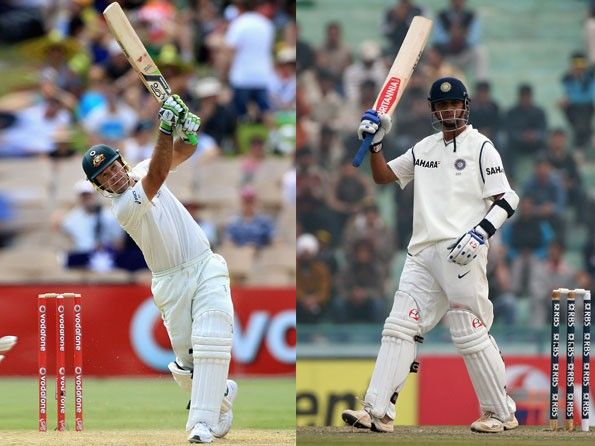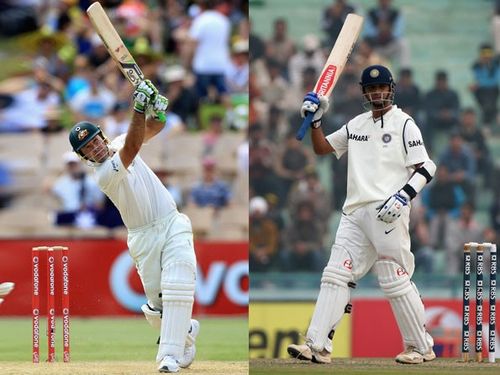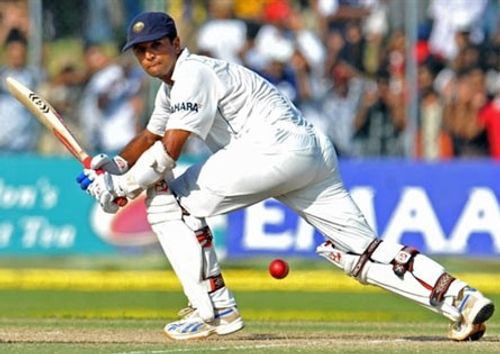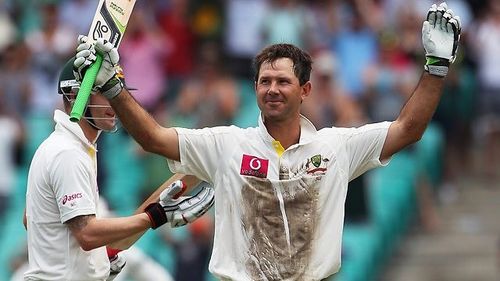
Rahul Dravid vs Ricky Ponting: A statistical comparison

All our lives we have been aware that contradiction is the very nature of existence. The very same individuals who are responsible for adding meaning to the network called life often provide us with the greatest paradoxes.
While carving out the path to success, you embroil yourself with a set of values and virtues which hold you in good stead as you near your destination. While some choose to go about their way in a composed and dignified manner, the majority go on to be defined by a brash and aggressive attitude, whereby they take the world head on at any opportune moment.
The sporting circuit is one such arena, which houses and displays a plethora of human emotions. A streak of boldness by one player is effectively countered with a phase of calm tranquillity by another, who, in no time, becomes the face of his game on a global platform.
Cricket, no stranger to players who have threatened its label of a ‘gentleman’s game’, has and continues to witness a breed of players all unlike the other – some ranting and raging, others collected and unthreatening.
Rahul Dravid and Ricky Ponting. Two cricketers, one legacy. One sport, two phenomena. If we need to pick a word to describe Ponting, one would not see beyond hostile – hostile towards his opponents and officials. In a bid to outwit the world, Punter, as he is called, rarely threaded the rope of friendliness. His boisterous behaviour was synonymous with Australia’s rise to the top as champions, raising the bar for aggression by sledging at will and having countless run-ins with the match officials.
India, led by an equally audacious captain Sourav Ganguly, had in its ranks Dravid who, besides reaching the pinnacles of success on the batting front, stood out for his sportsmanship, rarely taking blows at the world. ‘The Wall’ assumed his position as one of India’s greatest ever, both on and off the field, by adopting a technique befitting a gentleman.
Despite their differences, however, the world of cricket will forever be indebted to these two heroes who set the standard for excellence. Dravid and Ponting might have been as distinct as the two poles, but they inspired an entire generation with their hard work and sporting achievements.
Dravid and Ponting: Great ambassadors of Test cricket
In the age of hurried cricket games courtesy the T20 revolution, Test cricket has still managed to retain its legion of followers. The cricketing career of Indian great Sachin Tendulkar, which spanned from 1989-2013, saw some of the best Test players take the field.
A match winning 100 by either Brian Lara or Jacques Kallis immediately set up the stage for endless debates and arguments, with critics unashamedly comparing their heroics and feats to the other champions of the bygone and the present era. Comparing and contrasting numbers, however, is a challenge in itself – they are in no way a reflection of greatness, but only a set of records that have been garnered over a period of time by individuals who have dished out consistent performances.
Debuting 6 months from each other – Ponting played his first match against Sri Lanka on 8th December 1995, with Dravid playing his maiden Test in June 1996 – the two players had an almost similar start, scoring 96 and 95 respectively in their maiden outing. Swiftly dealing with the heartbreak of missing out on a well-deserved ton, the duo, by notching up consistent performances, became the faces of Test cricket on either side of the millennium.
A look at the overall Test figures of Ponting and Dravid will reveal two careers that have moved almost identical to one another, culminating in statistics eerily alike.
|
Overall Test figures for Ricky Ponting and Rahul Dravid |
||||||
|---|---|---|---|---|---|---|
|
Player |
Matches (innings) |
Runs |
Average |
Highest Score |
100’s |
50’s |
|
Rahul Dravid |
164 (286) |
13,288 |
52.31 |
270 |
36 |
63 |
|
Ricky Ponting |
168 (287) |
13,378 |
51.85 |
257 |
41 |
62 |
After 2003 (where he averaged 100.37), Dravid experienced his best year on the circuit in 2009, averaging 83. He was also colossal in 2011, scoring 5 centuries – equalling the most tons scored by him in a calendar year. His career average dropped from 57.25 to 52.31 due to a lean run of form in 2007 and 2008. During the dismal tour of Australia in 2011-12, he averaged only 24.25, scoring 194 runs in 8 innings, after which he announced his retirement.
Ponting, on the other hand, last averaged in excess of 50 in a calendar year way back in 2008. He had his best years from 1999 to 2003, averaging 67.28 in the 5-year period. He only averaged 28.05 from 2010 until his retirement in 2012, a major reason why he ended with an overall average of just over 51.
The invaluable number 3 spot: what the numbers reveal
Adapting to all kinds of situations, dropping anchor for the team, mixing caution with aggression – these have been the hallmark features of a great number 3 batsman, especially in Test cricket. Coming in right after the dismissal of the openers for a major part of their careers, both Ponting and Dravid had the tough task of consolidating and building up an innings, be it after an early wicket or a flying start.
It was a role carried out with aplomb by both the batsmen.
|
Test figures for Ponting and Dravid while batting at number 3 |
||||||
|---|---|---|---|---|---|---|
|
Player |
Matches (Innings) |
Runs |
Average |
Highest Score |
100’s |
50’s |
|
Dravid |
134 (219) |
10524 |
52.88 |
270 |
28 |
50 |
|
Ponting |
113 (196) |
9904 |
56.27 |
257 |
32 |
43 |
Starting as middle order players, the duo managed to make the number 3 spot their own after consistent performances that invariably reflected in the success of their respective teams. Although Ponting averages higher than Dravid while batting at number 3, one cannot overlook the fact that the Indian played a major part of his career sans a stable opening pair, which meant that he had to be out on the crease earlier than expected on most occasions.
Ponting, on the contrary, had one of the most dangerous opening pairs in Justin Langer and Matthew Hayden, who helped relieve the pressure off the No. 3 as well as the rest of the team.
While Dravid averaged 51.35 batting at number 3 overseas, Ponting’s average dropped from 56.27 to 50.06 whenever he played away from Australia, primarily because of his unflattering records in England and India.
Another argument, which works in favour of Dravid, is the fact that he faced the likes of Jason Gillespie, Shane Warne and Glenn McGrath, unanimously considered the best bowlers of the era, while the only consistently great bowler that Ponting faced was Sri Lankan spin wizard Muttiah Muralidharan and to an extent India’s Anil Kumble, against whom he rarely scored the runs expected from a player of his calibre.
Performance in different conditions: a reflection of skills
The true reflection of a player’s resilience and technique comes to the fore when you consider his performance away from the comforts of familiar conditions, in alien situations. If you still manage to perform in accordance with the stature that you have garnered at home, you are a certified great.
|
Averages of Ponting and Dravid in different conditions |
||||
|
Player |
In South Africa |
In England |
In Australia and New Zealand |
In the Subcontinent |
|
Rahul Dravid |
29.71 |
68.80 |
52.74 |
58.26 |
|
Ricky Ponting |
46.85 |
41.79 |
58.65 |
72.27 |
It is surprising to see Ponting averaging 72.27 in the Indian subcontinent, considering that spin was always his biggest nemesis. Before jumping the gun, one must note that his average shoots up considerably courtesy his performances in the two games against Bangladesh and a solitary game versus Pakistan. In the three games played against these two nations, he averaged 107.25 alone.
This is in huge contrast to his performances in India though – 14 matches, 662 runs at an average of 26.48.
Way back in 2001, when Ponting was in the midst of a golden run, he toured India. It was a series best remembered for India’s stunning fightback, as the Aussie legend scored 3 ducks in 5 innings, at a dismal average of 3.4!
His highest 4th innings score in India is just 12 – reinforcing the fact that spin was his biggest Achilles’ heel.
Dravid faced the biggest blips in his career whenever he toured South Africa, managing only one century in 11 games. However, he was a revelation whenever he returned to the country where he made his debut, scoring 6 centuries in England. His overall average against Australia stands at 38.67, which increased to 41.64 when he was playing Down Under. His numbers would have been higher had he not experienced the failure in Australia in his last series, which prompted his retirement.

Contribution as the Test progresses
While the first two innings of a Test match are usually considered the best for batting (unless the conditions are tailored otherwise or there is a burst of spirited bowling by the opposition), it is the performance in the last two innings of a Test match that usually differentiates the greats from the mortal players. Dragging the team along in tough situations and displaying an inspired phase of determination under pressure, a third or fourth innings century gives a fair idea of the mettle of the player.
|
Runs scored by Dravid in the 1st, 2nd, 3rd and 4th innings of a Test match |
|||
|
Innings |
Matches |
Runs |
Average |
|
1st innings |
75 |
4121 |
57.23 |
|
2nd innings |
89 |
4984 |
60.78 |
|
3rd innings |
67 |
2608 |
42.75 |
|
4th innings |
65 |
1575 |
40.38 |
|
Runs scored by Ponting in the 1st, 2nd, 3rd and 4th innings |
|||
|
Innings |
Matches |
Runs |
Average |
|
1st innings |
92 |
5403 |
61.39 |
|
2nd innings |
76 |
3964 |
52.92 |
|
3rd innings |
78 |
2544 |
38.54 |
|
4th innings |
56 |
1462 |
50.41 |
While Ponting inches ahead of Dravid in the first innings, the Indian averages better in the 2nd and 3rd innings. A wide gap, however, exists between the duo in the 4th innings. While Ponting has 4 hundreds in the last innings, Dravid has a solitary ton – 103* scored against New Zealand way back in 1999.
Looking at the numbers alone, one would be quick to dismiss Dravid’s skills in the 4th innings. In the last six years, his highest score in the 4th innings was 38, which in no way is acceptable from a player of his stature. However, here is where the numbers betray. What they do not reveal are the balls faced by the Bangalorean – a staggering 3,998 deliveries, almost 800 more than the second placed Tendulkar. Further, he has spent a whopping 24 sessions batting on the last day to save the team from the jaws of defeat.
He might not have a strike rate to boast of, but then one does not look at that column after a match-saving effort. The ability to stand at the crease and defy the opposition the jubilation of a victory is what matters most – an area where Dravid emphatically triumphs over the others.
Considering his teammates’ shortcomings in the 4th innings, Dravid was often a lone warrior waging a battle for salvation as the others crumbled around him. Ponting was blessed to be a member of a once-in-a-lifetime team, where all 11 players fought tooth and nail for a triumph.
Contribution in wins and draws
A huge factor that helps in categorizing a player as a true great or merely very good is his performance in winning causes. Ponting has the best centuries to matches won ratio – more than the stalwarts Tendulkar, Lara, Kallis or Dravid have.

|
Contribution by Dravid in wins/draws |
|||
|
|
Matches |
Runs |
Average |
|
Contribution in wins/draws (overall) |
115 |
10510 |
65.29 |
|
Contribution in wins/draws overseas |
57 |
5439 |
71.56 |
|
Contribution in wins/draws in the 4th innings |
41 |
1083 |
67.68 |
|
Contribution by Ponting in wins/draws |
|||
|
|
Matches |
Runs |
Average |
|
Contribution in wins/draws (overall) |
137 |
11342 |
55.74 |
|
Contribution in wins/draws overseas |
50 |
4025 |
53.66 |
|
Contribution in wins/draws in the 4th innings |
43 |
1234 |
77.12 |
However, a look at the table above suggests how far behind he is of Dravid as far as performances in match winning or saving efforts are concerned.
Dravid averages 71.56 in matches won abroad, playing a huge hand in almost all overseas victories accorded by the team this millennium, including Leeds in 2002, Adelaide in 2003, Rawalpindi in 2004 and Perth in 2008, to name a few. That amply proves how important his contributions were for the team.
Ponting lags behind with an average of 53.66 in winning or match saving contributions abroad. He went without a ton from 2006 until 2008, a phase when Australia were at their pinnacle, winning almost every game that came their way. Failure to perform consistently when the team was routing the rivals, naturally reflects in his figures.
Even though he averages significantly less than Ponting in wins and draws in the 4th innings, of the eight fifties scored by Dravid in the last innings of a Test, six have resulted in either a victory or a draw, highlighting how crucial his performances were for the team.
Leading from the front as a captain
The stamp of a great leader is undoubtedly his ability to inspire his troops, by leading from the front and taking the initiative to score runs when the team is in dire straits. Comparing captain Ponting to captain Dravid would, however, be foolish, to say the least. With a win percentage of 62.33, the Australian is regarded as one of the finest captains ever produced, while Dravid, who donned the leadership cap after a bitter fallout between Ganguly and then coach Greg Chappell, has won only 32% of his games.
|
Performance as captain |
||||
|
Player |
Matches played as captain |
Win% |
Runs |
Average |
|
Dravid |
25 |
32% |
1736 |
44.51 |
|
Ponting |
77 |
62.33% |
6542 |
51.51 |
Dravid scored his first 50 as captain after 12 innings and managed only four hundreds in the 45 innings he batted while as captain. His win percentage is a huge contrast from Ponting’s, who lead possibly one of the greatest teams ever, comprising 11 invincibles. Dravid’s India, meanwhile, was slowly but surely making its mark as a competitor in the world of cricket.
It would, therefore, be unfair to comprehend either player’s true captaincy skills, given the fact that the teams they led were anything but similar in terms of skill and potential.
Final verdict
While one player stood out for an orthodox endurance that saw him define Test cricket, the other was characterised by an attacking game that redefined the way a five-day match came to be played.
Sidelining a player or elevating another based on mere numbers is highly contentious – it does not take into account the form of the bowlers nor does it reveal the pitch or conditions that were on offer. But as time wears on and a new era dawns, we will find newer methods to judge their greatness.
Players might take their place, but the legacy left behind by Dravid and Ponting ensures that they will forever be irreplaceable.